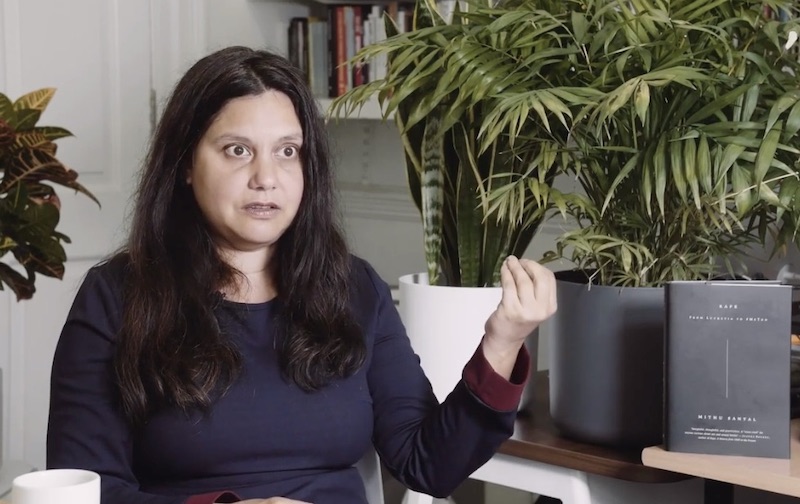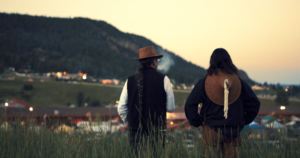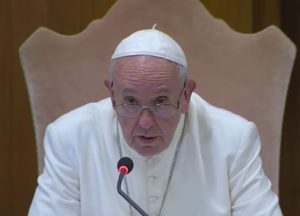What We Talk About When We Talk About Rape
Mithu Sanyal tackles some thorny questions surrounding rape, including the pressures we place on victims to speak out, in her meticulous new book. Author Mithu Sanyal discusses her book "Rape: From Lucretia to #MeToo" in a video posted to her publisher's website. (VersoBooks.com)
Author Mithu Sanyal discusses her book "Rape: From Lucretia to #MeToo" in a video posted to her publisher's website. (VersoBooks.com)
“Rape: From Lucretia to #MeToo”
A book by Mithu Sanyal
Mithu Sanyal’s “Rape: From Lucretia to #MeToo” is a book about what we talk about when we talk about rape and how we talk about rape. Sanyal tackles some thorny questions, among them the sensationalism that surrounds rape, the pressures we place on victims to speak out, and our dominant narrative of female sexual victimization. Her work is meticulous and stands on the shoulders of second-wave giants such as Susan Brownmiller and Susan Griffin, who argued that rape is not sex, but violence. This is such an established concept today that it is hard for younger people to fathom its significance back in the 1970s. But when Brownmiller’s “Against Our Will” (1975) asserted that rape is “nothing more or less than a conscious process by which all men keep all women in a state of fear,” it was a major discursive turning point. Likewise, with Griffin’s thesis, rape is “an act of aggression in which the victim is denied her self-determination.” Griffin was writing in an essay entitled “Rape: The All-American Crime,” published in 1971, and went on to publish a book-length study of the issue, entitled “Rape: The Power of Consciousness,” in 1979. It is obvious from its title that Sanyal’s book is being pitched both as a reprise of this work and a survey of the intervening years. (She is also heavily indebted to Joanna Bourke’s more contemporary and similarly entitled “Rape: A History from 1860 to the Present.”) Where Sanyal covers new ground is in examining the evolution of rape discourse itself and questioning how far it has come.
Click here to read long excerpts from “Rape: From Lucretia to #MeToo” at Google Books.
To this end, Sanyal gives us a potted judicial history of the crime: how it is defined, how it is criminalized—in short, what rape has really been about over the years. In the Hammurabi Code, for example, it is defined as theft of virginity, the only thing by which a woman can be defined in society. But to think of rape as the theft of the woman’s virginity would be naive. Virginity did not (has not until very recently and still does not in many places around the world) belong to the woman, but rather to her husband or father. Rape in this period is therefore a homosocial act, one committed by one man against another through the conduit of a woman—as illustrated by the fact that in Assyria, the punishment for rape was for the perpetrator to hand over his wife to the raped woman’s father (an eye for an eye). Its homosocial nature is further understood if seen alongside adultery, an antiquated phrase for which highlights the relationship between both male parties: Man 1 cuckolds Man 2 by having sex with Man 2’s wife. “Wife” is the crucial part of the equation, but absent from the phrasing: the means but not the end. In the case of rape, it is Man 2 who is absent from the phrasing, but no less a victim of the act.
Rape’s categorization alongside adultery appears again in 13th-century Britain. In the Statutes of Westminster, both are considered crimes against the social order. By the statutes’ logic, all sexual acts unconducive to reproduction within wedlock (adultery, homosexual sex, masturbation, and rape) become crimes against “public decency,” and perversions of the state’s desired course of civilian life as a life plot that moves rapidly toward the culmination of marriage and babies. In Germany, an almost identical definition of public decency is made law in 1871, when Germany first becomes a unified country. This is noteworthy, in that it highlights how much the “wrong” sex is a source of anxiety for a nascent nation-state. That this legal codification crops up in the separate contexts of 1275 England and 1871 Germany is revealing. It means our perception of rape has stagnated for long periods of history.
Eventually, we came to the modern understanding of rape, which Sanyal asserts, “is rooted in the European Enlightenment and Western liberalism, and thereby based in the idea of property—just as the original understanding of rape was.” Specifically, she cites property in the Lockean sense: “Though the Earth, and all inferior Creatures be common to all Men, yet every Man has a Property in his own Person. This no Body has any Right to but himself.” Our perception of female personhood may have greatly improved, therefore, but rape’s dialectic of ownership has remained in place since 4000 BCE. At present, this takes shape in an “antagonistic and gendered giver-receiver model,” wherein the receiver of consent (imagined as male) has to ask, and the giver (imagined as female) is supposed to say yes or no. In the words of sex educator Rona Torenz: “That is not a good model for relationships, sexual or otherwise.”
Not only that, but our understanding of rape’s aftermath has not changed as much as we might think. Though we have come astonishingly far in very little time, we find ourselves in a moment where there is a great deal of pressure on victims to speak out. It goes without saying that such sensitive story-sharing is enormously powerful and provided the basis of women’s liberation movements from a near-half-century ago. More recently, hashtag-led movements such as #YesAllWomen and #MeToo have provided the “empowerment by empathy” cited by Tarana Burke. The grassroots story-sharing of last year’s Irish campaign to repeal the eighth amendment #InHerShoes saw thousands of the country’s recent diaspora flying home to vote, swing the referendum, and thereby defeat one of the world’s most powerful para-political organizations, the Catholic Church.
But this is a tactic we have had for a very long time. In making story-sharing the primary recourse of survivors, we run the risk of retraumatizing those who may not wish to reexcavate their experience in public. Furthermore, the recollection of one’s own experience of sexual violence has become so established in explorations of the subject, that it verges on set piece, as if trauma were a sole conveyor of authority on the subject. In making it the standard peg of discussion, we run the risk of becoming consumer-recipients hankering for female pain, unable to move past the immediate identification with an individual. Mychal Denzel Smith writes about a parallel phenomenon in his essay “The Gatekeepers: On the burden of the black public intellectual,” examining the discourse surrounding the fight for black lives:
[T]he black public intellectual, so defined, is largely responsible for defenses and explanations of black culture, or for arguing in favor of black people’s humanity and right to life, for a white audience. This necessarily constricts the questions we are able to ask and degrades the level of discourse. Consider the amount of energy expended by black writers and pundits defending the character of victims of police violence. To participate in this dialogue requires an excavation of black pain for the consumption of a white public; it takes up space that could otherwise be used to consider the function of policing or the root causes of racist violence. It leaves no room for new ideas or even real debate. […] White people assign the stories, produce the television segments, and book the radio guests, and they seek out narrative structures they understand. They call upon black public intellectuals to speak to the tragedy of black lives defined by violence, or to make sense of black cultural trends, while diverting attention and energy away from more challenging work that is often relegated to smaller platforms. […] As a writer, I have spent more time asking white people to see me as human than I have thinking about the world I would like to live in.
Similarly, women have spent decades arguing that rape is violent, traumatic, and banal. As with the humanity of black lives, we have spent far too long stuck making obvious assertions, and not enough imagining the world we would like to live in, and how we get there.
The pressure to reminisce on one’s own trauma is also to fall back into the trope of the fallen woman who is publicly defined by the harm done to her, a tendency that has repercussions for our understanding of female sexuality. “In my political writing, I found out, it was easier to talk about being raped, than to talk about all the positive sexual experience that I have had,” Sanyal writes, ruefully. “When breaking the silence is taken up as the necessary route to recovery or as a privileged political tactic, it becomes a coercive imperative on survivors to confess.” And we have failed to bring our expectations of trauma with us, even as we make vast strides in convincing people how common rape is. Megan Nolan of the New Statesman writes that rape is “perceived as a singular crime of life-ruining magnitude (which, of course, it may be)—and yet it is also common as muck.” Sanyal corroborates, quoting Samantha Geimer: “You don’t have to fall apart to show that what happened to you was wrong.” To place such emphasis on public discussion of rape is to render female sexuality an externally defined thing, and often in painful terms.
What is most noteworthy about the evolution of rape’s criminalization is that we have moved from a communal definition of rape to one that’s more centered on the individual; from a rupture in the social fabric to a psychic wound in the victim themselves. As we have shed both pre-Enlightenment notions of the body politic and pre–Gay Liberation notions of public decency, we have redefined the individual in more narrow terms. We place discomfiting emphasis on the individual as an individual body, and not the responsibilities it may bear to others, or legislative, judicial, and political bodies. This is part of a dominant neoliberal ideology which seeks to deny the interactions between phenomena—be that inequality and sexuality, or a living wage and the opportunity for full sexual self-determination—and suppresses how subjects shape the state.
Sanyal addresses this in one of her closing points. Referring to countries outside of our Western (neoliberal) gaze, she cites the Minangkabau in West Sumatra, to whom rape is “hardly know[n].” By comparison, rape in the US prison system is “unimaginably common.” The more equal a society, she ventures, “and the higher its opportunities for participation, the lower its rape rate.” That this crime which has been embedded in our societies forever could be greatly diminished by expanding the opportunities to engage in society is certainly an appealing proposition. It is a shame that Sanyal does not give herself the room to explore quite how, but she has given us a survey of an issue at the heart of how we live with one another in the here and now.
This review originally appeared on the Los Angeles Review of Books.
Your support is crucial…
With an uncertain future and a new administration casting doubt on press freedoms, the danger is clear: The truth is at risk.
Now is the time to give. Your tax-deductible support allows us to dig deeper, delivering fearless investigative reporting and analysis that exposes what’s really happening — without compromise.
Stand with our courageous journalists. Donate today to protect a free press, uphold democracy and unearth untold stories.






You need to be a supporter to comment.
There are currently no responses to this article.
Be the first to respond.